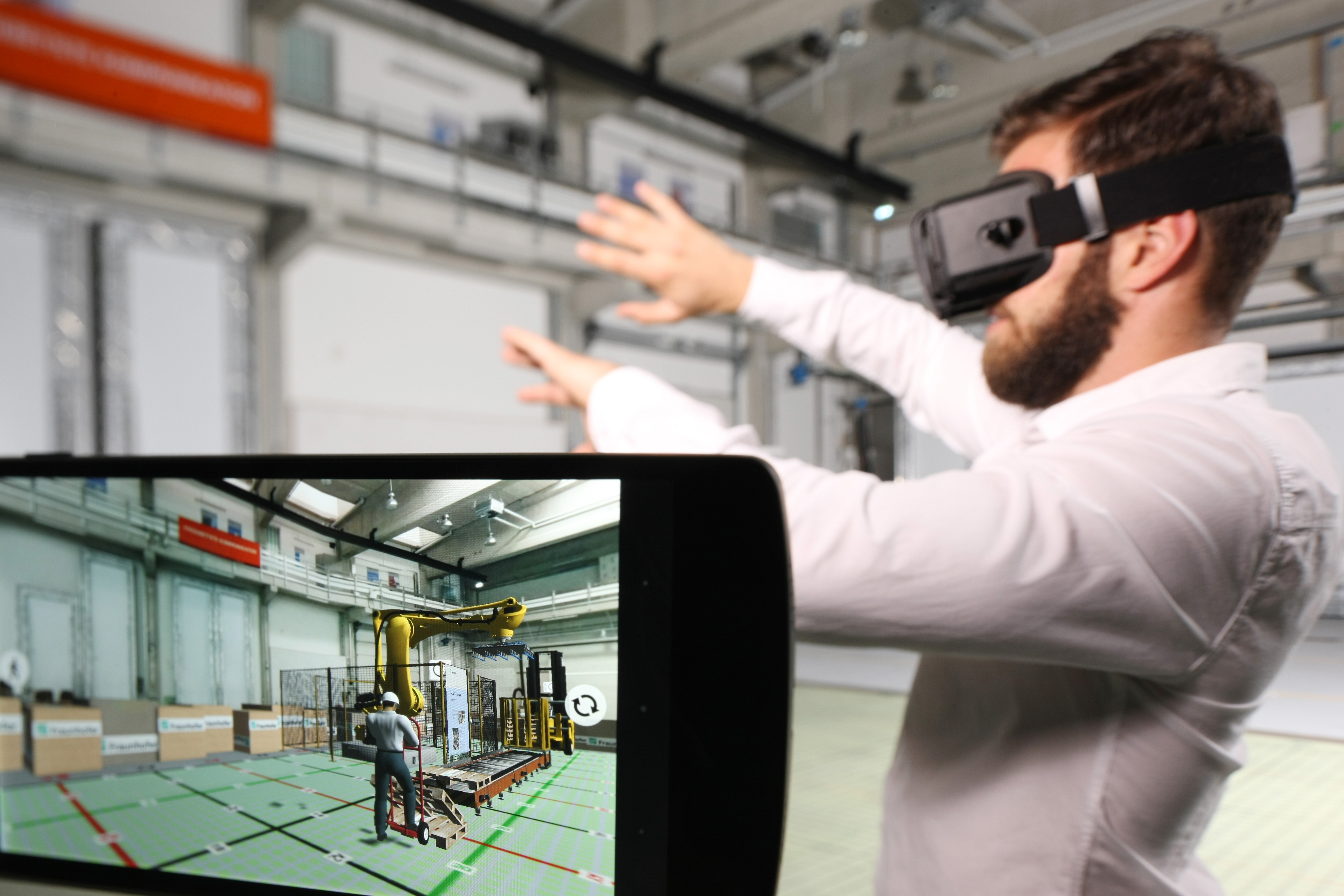Knowing where to go in virtual worlds!
Erlangen/Nuremberg, March 18, 2015: Virtual reality (VR) makes it possible to immerse oneself in new and unfamiliar computer worlds. This technology features strengths that industrial companies, architects and city planners are finding increasingly important for their planning and training processes. To support such applications, researchers at the Fraunhofer Institute for Integrated Circuits IIS are now offering high-performance positioning technology that can be integrated into these systems. Precision positioning allows multiple VR users unrestricted mobility in both indoor and outdoor environments.

Today, anyone can don a pair of virtual reality goggles and immerse themselves in a virtual computer game world, taking a journey of discovery by means of nearly-realistic graphics scenarios. Search for treasure, build a new city or compete to see how one stacks up against other players. The problem is, completely natural movements without a keyboard, mouse or joystick are possible only in a limited number of VR rooms or via so-called omnidirectional treadmills. To walk through and experience large environments as naturally as possible, the system must offer authentic movements, a capability that is available only on a very limited basis with current VR simulation platforms. This is exactly what the market is demanding however, especially for professional applications used by city and company planners who require precise feedback from users. This area is the focus of researchers at the Fraunhofer Institute for Integrated Circuits IIS who are offering a new level of quality for the virtual reality experience.
Positioning technology for VR applications – unrestricted mobility both indoors and outdoors
Thanks to years of experience in this field, Fraunhofer IIS has wireless communication and positioning technologies that make it possible to enhance the virtual reality experience with precise user as well as object movement and positioning. The combination of image and positioning technologies results in nearly unlimited mobility in indoor or outdoor areas as large as several thousand square meters, such as warehouses or production facilities. Planners can thus use the combined VR wireless solution to install machines in the right place or to virtually experience, plan and optimize work flows, escape routes and other objects. Integration of the positioning technology opens up new positioning applications which to date have not been possible to implement, even outdoors. This combination of technologies allows the use of outdoor virtual reality applications for city, building or traffic planning, as well as for training purposes on the playing field.
Knowing where to go with virtual reality – precise and safe
The positioning solution is based on the RedFIR system developed by Fraunhofer IIS, which relies on radio technology to acquire precise positioning data with up to 2,000 positions per second. The system is utilized especially for optimizing practice routines in soccer and rugby, which involves tracking player and ball movements and referencing them to specific situations so they can be analyzed. The integrated positioning capability is what makes it possible for users to naturally move around in warehouses, buildings and outdoor grounds using superimposed virtual reality. That means no longer being restricted to a small playing area. VR goggle systems can adapt to the typical strategies and movement flows of the real world, thus placing less emphasis on the technology itself.
One unique advantage of incorporating the positioning technology into the VR system is that multiple users can participate without the risk of collisions. In contrast to optical systems, there are no obstructed views. Planners can try out and experience different steps and analyze the impact on future building and process designs during the early stages of development. This leads to significantly more reliable and faster planning and decision-making during design and implementation. Costly mockups are no longer required.
Fraunhofer IIS researchers are utilizing this positioning-enhanced VR approach for gaming systems, as well as for sports and fitness applications. The next logical step is use with augmented reality applications, which can benefit much more from precise positioning technology.
Positioning technologies
Researchers in the area of wireless positioning and communication at Fraunhofer IIS in Nürnberg work with various partners to implement virtual and augmented reality applications. The range of services includes both indoor and outdoor solutions for meter- to centimeter-precise positioning. The VR user's viewing direction is detected by various sensors (accelerometer, gyrometer and magnetometer) and then merged with the positioning technologies using sensor fusion methods.
Examples of where positioning technologies are used include awiloc, a system for precisely positioning objects in indoor and outdoor areas, and RedFIR, a technology that provides centimeter-precise indoor and outdoor positioning and highly-precise satellite-based positioning. One of the applications for the awiloc technology, which was developed for the Egyptian Museum in Munich by Fraunhofer and NOUS Wissensmanagement GmbH, is a museum guide that navigates visitors through a 3D-based virtual world.